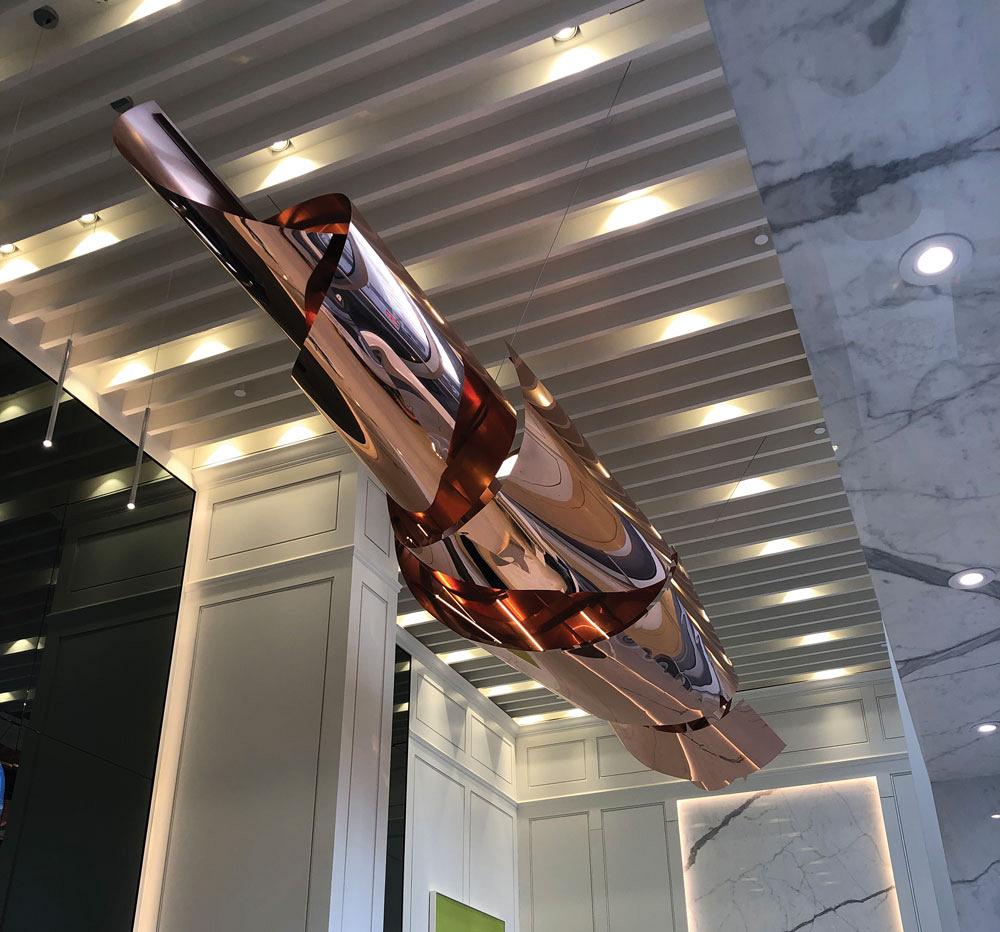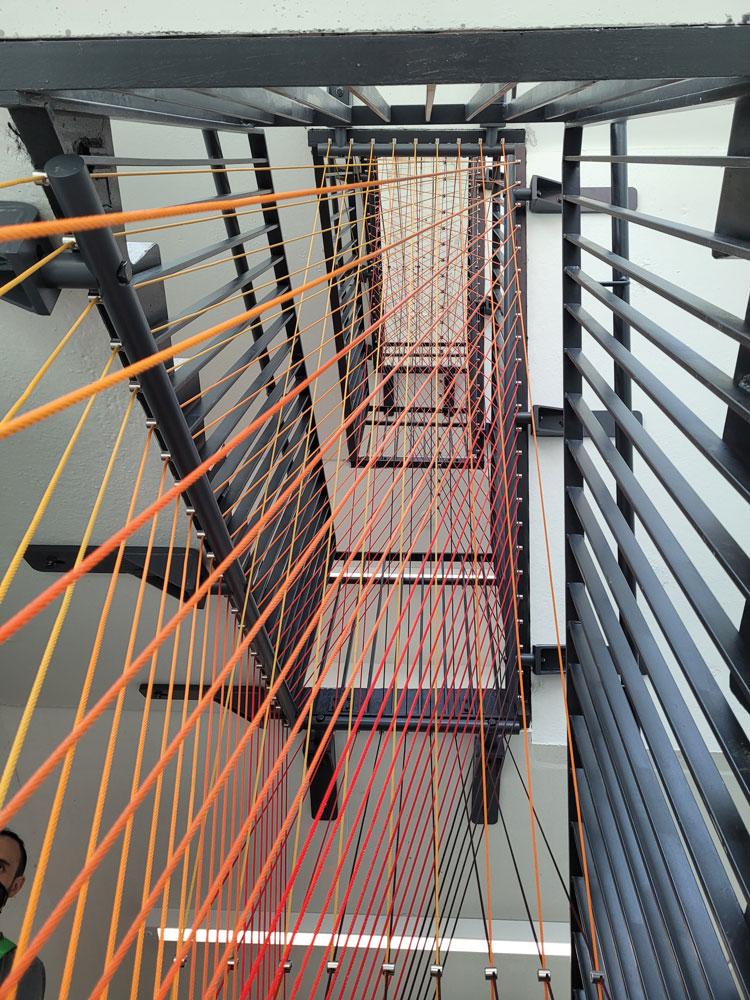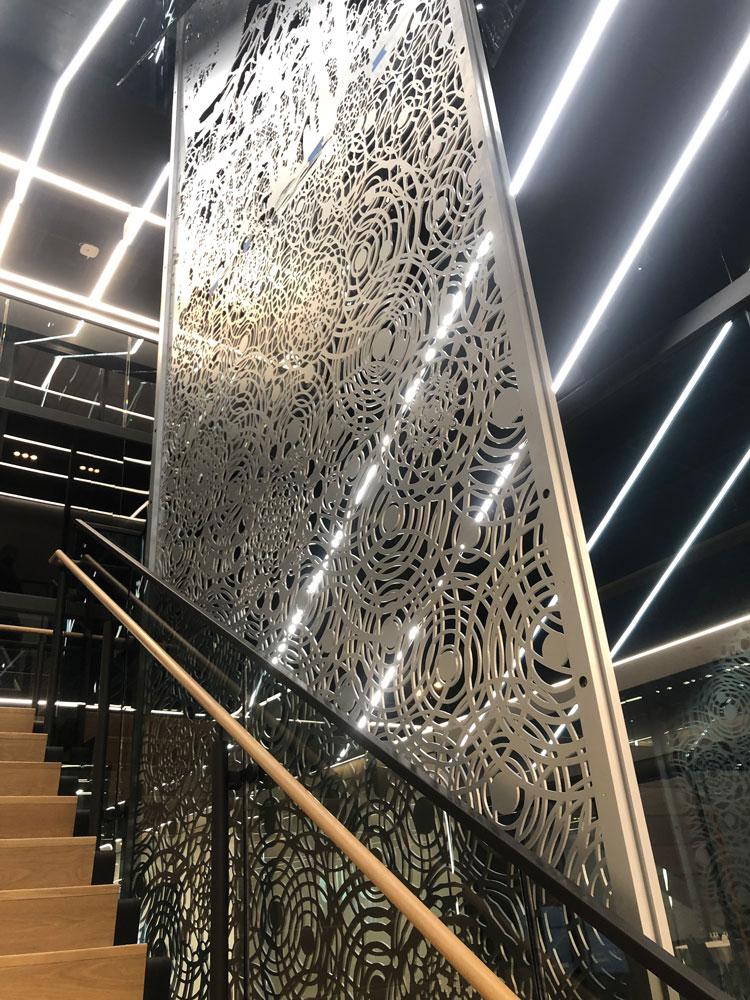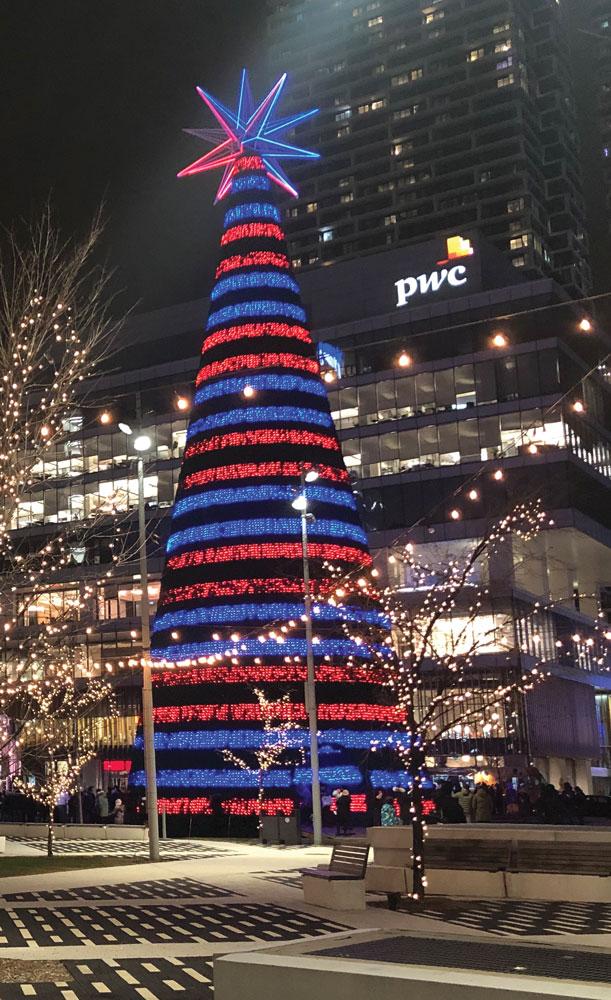Editor
- FMA
- The Fabricator
- FABTECH
- Canadian Metalworking
Adjusting for growth at Sixpenny
Architectural fabrication company evolves with new facility, equipment, and management tools
- By Rob Colman
- March 30, 2023
- Article
- Fabricating

This decorative light fixture, created for the Selby apartment development in Toronto, is mirror-polished, laser-cut, lacquered copper riveted to an aluminum frame. Images: Sixpenny
Every company has a growth arc, and each takes its own unique path to success. For David Nolan’s company Sixpenny Architectural Fabrication, the development has involved changing the original owners’ concept and investing in the hardware and management tools to help it grow. After 10 years at the company, he’s starting to feel it’s where it is meant to be.
Shifting Focus
When Nolan moved to Toronto in 2012, not long after graduating with a mechanical engineering degree, he decided to pursue a career in metalworking.
“I’ve always enjoyed working with my hands, figuring out how things are made,” he said. “During the summers while at school, I worked on carpentry jobs and got a lot of satisfaction out of seeing how jobs were managed and seeing them through to their completion. So when I moved to Toronto, I got some contract work welding and doing some carpentry. My main focus was learning how to run a business.”
It was 2014 when he started collaborating with the owners at Sixpenny, doing some metalworking jobs connected to the carpentry work the company was founded to pursue. (A sixpenny nail is historically the most common type of nail, hence the name Nolan has retained.) This work included store fixtures and residential installations. When one of the partners left the company, Nolan joined as an official partner. The company continued to grow, doing custom office, retail, and residential architectural jobs.
“When the second owner decided to leave, I decided to put an end to work doing wooden doors and windows,” he said. “My interest was always in metalworking and finishing in the architectural fabrication space. This has been our focus since 2016. We’ve developed a busy niche in public art and complex installations for commercial and institutional clients.”
Custom Variety
Sixpenny is based in a 16,000-sq.-ft. facility in Toronto, where Nolan moved the company in the summer of 2022.
“It’s one of the few industrial buildings still available in the heart of the city and is a perfect space for us to grow, with plenty of room for more equipment and a better layout than our former location,” he said.
The shop comprises a team of 10, four are dedicated fabricators and the fifth focuses mainly on operating the shop’s recently purchased laser cutting table. Beyond a press brake and welding centres, the shop also runs mills and lathes for any machining work necessary for projects.
The jobs the company is hired to custom fabricate are many and varied. In terms of sheer size, a good example at the top end is the 108-ft. steel Christmas tree erected at the Vaughan Metropolitan Centre. Designed by Nolan, it was covered in LEDs and designed to allow people to wander through the centre of the structure.
“The finished product is ultimately fairly simple in terms of the metalwork involved, but impressive to stand in front of,” said Nolan. “It is 40,000 lbs. of material, held in place by 12 piles that are put 20 ft. into the ground. I designed it so that it is relatively simple to take apart at the end of the holiday season and to be stored in crates. It’s our biggest project to date.”

This decorative light fixture, created for the Selby apartment development in Toronto, is mirror-polished, laser-cut, lacquered copper riveted to an aluminum frame.
Another interesting installation is one the company completed in support of architectural firm Diamond Schmitt at McMaster University. The concept was to fill two 10-storey stairwells with safety cable to avoid fall concerns. But it was designed to be aesthetically pleasing, with the multicoloured cables criss-crossing in such a way that it comes across as a cat’s cradle or an intricate web.
“It involved a great deal of steel hardware and custom-machined components and a lengthy installation process,” said Nolan. “Ultimately, it was very rewarding.”
Cutting Capabilities
At this writing, Nolan and his team were working on three distinct projects: cutting and welding abstract stainless steel horse sculptures for Toronto’s Woodbine Hotel; completing copper artwork for the exterior of a Toronto condo; and installing exterior stairs, a task that Nolan himself was busy working on.
The challenge of handling a wide project range with such a small team comes down to management. Nolan said the addition of the laser in 2022 has helped them manage cutting jobs efficiently.
“It’s a 4-kW CO2 AMADA machine with a 13.5-ft. by 6.5-ft. table that I picked up used,” he said. “It’s been a game-changer for us. With the table being as large as it is, we can cut very large panels on it. But also, if we have multiple materials, we can set up zones on the table and have a couple different sheets on there and be cutting them at the same time without worrying about constantly changing material over. It was random chance that the table was as large as it was. It was available and I liked the seller, so it was more serendipitous than anything else.”
The seller had a maintenance contract with AMADA CANADA for the machine and Nolan did the same, which he said has been a huge help.
“It is an older machine, and my experience with lasers was limited before I purchased this,” he noted. “When I’ve had an issue in the early stages of owning it, they’ve responded immediately. It’s been a great help.”
For most of the large projects, Nolan subcontracts the laser cutting work to a trusted supplier outside of the city. For instance, the Christmas tree was cut by this supplier. Laser-cut tubes that could be slotted into high-strength steel members were the main components. The size of the order and the precision necessary made it a perfect candidate for that particular shop.
“Ultimately, we don’t have the infrastructure or the desire to be cutting sheet or tube all day,” said Nolan. “We are here to develop the concepts, map them out in SolidWorks, and ensure all the pieces fit together effectively and efficiently.”
Having the laser in-house is a difference-maker for prototyping designs and replacing the occasional damaged part that comes in from a supplier.

An interesting example of the breadth of Sixpenny’s designs is a McMaster University installation, the concept of which was to fill two 10-storey stairwell areas with safety cable to avoid fall concerns. It was designed in such a way that is aesthetically pleasing. Shown is the hardware required, providing a sense of the design challenges and mix of fabricating and machining work used to make the design a reality.
“When we do get to the point where we’re ordering from our suppliers, we need to make sure everything is going to piece together correctly and meet our design specifications,” said Nolan. “This ensures we get the design right the first time.”
Hand-held Laser Welding
Although he hasn’t used it very much yet, Nolan also has invested in a new hand-held laser welding system. He sees it as a real speed advantage when working on light-gauge materials, especially when there are awkward fillet welds that are hard to polish smooth.
“We have been using it for the lighter parts of the horse sculpture. Not only can I get the inside fillet weld right with very little trouble, but I can lay down other welds quickly in one pass and then polish out the edges to create the proper finish. There is no burn-through on any of the welds; it’s a clean and fast process.”
Nolan is currently planning the construction of a fully enclosed area for this welding machine to ensure safe operation.
Workflow Tools
Nolan also has built some systems to help manage projects using the online workflow management platform called Monday.com.
“It helps me organize my workflow,” he said. “It’s a tool we use to help us keep our general schedule outlined and it gives everyone live access to the general plan. Through the platform, I can assign tasks to people and the task pops up on their phone. Given that our jobs are varied, sometimes a person with a certain skill set will need to switch from one job to another. I can keep track of that and assign work as necessary. Using a simpler platform like this, I can create a general task list for each job; tasks that have to be finished within a certain amount of time and in a certain order. I generally don’t have to send out tasks to people daily, but everyone being able to visualize what needs to be done on this platform allows for scheduling as necessary.
“We didn’t build the software behind the platform, obviously, but we built the tools that we want using that service,” he explained. “The flexibility of it is perfect for a company of our size. It has taken a while to hone in on what information we actually want to include in that system because we don’t want so much information flowing through it that it no longer helps us get the job done. It’s there to allow everyone to understand the overall picture and plan, and it works very well for that.
“It also makes it easy for us to update clients on schedules,” Nolan concluded.
He doesn’t see this being ideal for managing the company forever, though.
“At a certain point, we’ll hit 20 or 25 employees and suddenly managing the team is more complex,” he said. “But at least then we’ll know what we’re after in an ERP system. It’s a challenge to sort out all the different tools available and deciding which are the ones that best solve the problems that you’re trying to solve. Right now, this service works as our project management help and QuickBooks helps us track our project costs.”

This artwork, conceived of by artist Ed Pien and fabricated by Sixpenny, is located in the CIBC Tower in Toronto, runs from the sixth floor to the ninth floor, and is made up of many laser cut and machined aluminum panels that have been powder coated.
To manage material costs, Sixpenny generally works on a job-by-job basis.
“We use SolidWorks to design jobs for customers and do pretty exhaustive iterations of those designs to make sure we’re ordering the correct quantities,” Nolan said. “We really try to leverage digital fabrication techniques to make our lives easier and our work as fast and accurate as possible.”
Management Guidance
Over the course of his career as owner of Sixpenny, Nolan has increased its income fivefold or more.
Asked what advice he’d give to other small shop owners in terms of finding support for their growth, Nolan mentioned working with BDC [Business Development Bank of Canada] and taking their financial management program.
“We were talking to them about providing us with some financing,” he said. “While we didn’t take advantage of that, the financial management program was really helpful. We were paired with a coach over a course of 12 weeks. Every week we would spend about three hours working on spreadsheets, going through financial statements, creating different types of reports and performance indicators to help us really get a clear understanding of how to manage our finances and workflow at a granular level. It’s one of the most valuable things we’ve done in the past five years.”
Blue Sky Designs
Nolan’s sights are set well beyond his day-to-day work, though. His goal has been to create a business that is self-sustaining so that he can spend part of his time developing ideas to help the world more broadly.
It’s a lofty goal, but undeniably worth working toward—thinking about solutions to help address issues such as climate change, carbon capture, and energy storage. But Nolan likes these hours for blue sky thinking because the potential for making a change for the good is limitless.
“If I spend seven hours a day working on supporting clients, I might spend an hour exploring random ideas that my mechanical engineering and metalworking knowledge can help address,” he said. “For instance, we’ve submitted an application for a grant to explore a welding process that could be used in space. A solution to that issue would find applications elsewhere, of course. The way I see it is we’ve put together a team of really thoughtful, intelligent people at this company that are good at solving problems—any problems. Why not use that for a greater good?”
Editor Robert Colman can be reached at rcolman@canadianfabweld.com.
Sixpenny, sixpenny.ca
About the Author

Rob Colman
1154 Warden Avenue
Toronto, M1R 0A1 Canada
905-235-0471
Robert Colman has worked as a writer and editor for more than 25 years, covering the needs of a variety of trades. He has been dedicated to the metalworking industry for the past 13 years, serving as editor for Metalworking Production & Purchasing (MP&P) and, since January 2016, the editor of Canadian Fabricating & Welding. He graduated with a B.A. degree from McGill University and a Master’s degree from UBC.
subscribe now


Keep up to date with the latest news, events, and technology for all things metal from our pair of monthly magazines written specifically for Canadian manufacturers!
Start Your Free Subscription- Industry Events
Automate 2024
- May 6 - 9, 2024
- Chicago, IL
ANCA Open House
- May 7 - 8, 2024
- Wixom, MI
17th annual Joint Open House
- May 8 - 9, 2024
- Oakville and Mississauga, ON Canada
MME Saskatoon
- May 28, 2024
- Saskatoon, SK Canada
CME's Health & Safety Symposium for Manufacturers
- May 29, 2024
- Mississauga, ON Canada





















